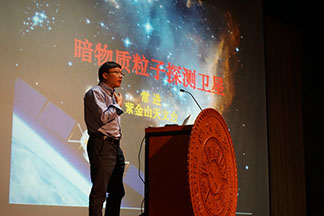On March 4th 2017, the 17th session of the "New Worlds, New Horizons" Public Lecture series was held in the Auditorium of Tsinghua University. Dr. Chang Jin, Deputy Director of the Purple Mountain Observatory, Chinese Academy of Sciences, and PI of the DAMPE project, presented the audience the breathtaking view of the satellite, its history and its missions. The lecture attracted approximately 500 on-site audiences and over 8900 on-line audiences.
DAMPE, the Dark Matter Particle Explorer was launched on December 17, 2015, aiming at detecting high energy gamma rays, electrons and cosmic rays to search for dark matter. Being China's first astronomical space observatory, the satellite was given a nickname "Wukong", which is the name of the hero Monkey King in the Chinese classic novel Journey to the West, who has particularly sharp eyesight. Meanwhile, "Wu" is for "understanding" in Chinese and "kong" for "the void", conveying the ardent hope of scientists for the observatory to open up a new window to understand the mystery hidden beneath the void, namely Dark Matter at present.

To understand the significance of DAMPE, some background knowledge of Dark Matter is essential. Dr. Chang offered a brief history of the discovery of a myriad of phenomena, e.g. that ordinary matter could not bind the clusters of galaxies concluded by the observation of their motion, and that the sun orbits the center of the Galaxy at a speed 50% faster than that deduced based on currently observed luminous matter, etc., which suggests the existence of Dark Matter that does not emit or interact with electromagnetic radiation (light), and is thus invisible in the entire electromagnetic spectrum.
There are three ways of Dark Matter detection: direct detection (which is usually carried out in the deep underground), detection with particle accelerators such as the Large Hadron Collider (LHC), and detection with space observatories. While the first two methods have not yielded satisfactory achievements so far, detectors with higher energy and better energy resolution power are urgently needed. The emergence of DAMPE, Wukong, is just at the right time.
Operating at an orbit 500km high above the earth, Wukong conducts high-resolution observation of high-energy electrons and gamma rays to detect the signals of annihilation and possible decays of dark matter particles. Apart from that, the observatory also sets target on cosmic rays, gamma rays and gamma ray bursts. Therefore, the crucial technique applied is the identification of particles that hits the detector. Utilizing advanced technologies involving silicon sensors and sophisticated circuit boards, and measuring each property of the particles with two sets of apparatuses, different cosmic rays can be distinguished by analyzing the different effects they have on the detector material. Recalling the long "journey to the west" of the project since the proposal of the idea in 1998, Dr. Chang demonstrated proudly that his team has now obtained the best energy resolution, the highest energy range, and the most efficient background suppression. Until Feb. 20th, 2016, DAMPE has already recorded 2.1 billion particles from cosmic rays, and observation information updates will soon be released in May 2017 by the satellite with unprecedented energy range above TeV.

Many questions were raised in the Q&A session and the speaker answered them one by one. Hypotheses on the possible identities of Dark Matter as well as the possible applications, the concrete statistical signals that will appear if Dark Matter is detected, and the comparison between DAMPE Project and other related projects, in particular the Alpha Magnetic Spectrometer (AMS) and the Fermi Space Telescope were among the questions. At the end of this talk, Dr. Chang dedicated the achievements to his team with almost twenty years' hard work and expressed gratitude to the support from Tsinghua University. We look forward to future discoveries that might bring great surprises to the nature of dark matter in the universe!